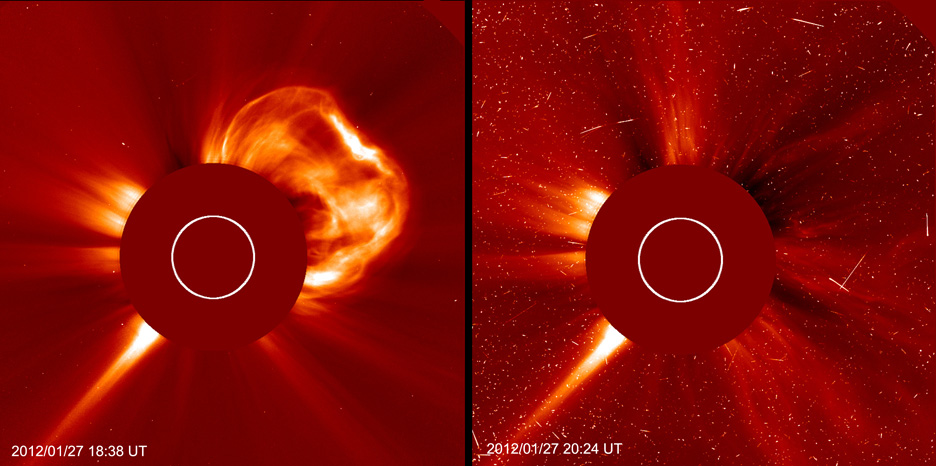Another Proton Storm
An X1.7 flare (largest category) and a coronal mass ejection (CME) erupted from the Sun (Jan. 27-28, 2012) from the same active region that produced a smaller but Earth-directed storm a few days earlier. This resulting solar storm was not squarely Earth-directed, but the clouds of high-energy protons that it emitted continued to hit the SOHO spacecraft detectors for over a day and did generate a minor radiation storm on Earth. (SOHO is about a million miles towards the Sun from Earth.) The CME raced away from the Sun at a fast at 2500 km/s or 5.6 million mph clip.
Credit: NASA/ESA/SOHO
<< Previous SOHO
SDO/SOHO: Pick of the Week (2012 Feb 03)
SDO/SOHO: Pick of the Week (2012 Feb 03)
Know the quiet place within your heart and touch the rainbow of possibility; be
alive to the gentle breeze of communication, and please stop being such a jerk. — Garrison Keillor
alive to the gentle breeze of communication, and please stop being such a jerk. — Garrison Keillor
SDO: Pick of the Week (2012 Feb 03)
Profiled Blast
An X1.6 flare (in the largest category) erupted (Jan. 27, 2012) along with a coronal mass ejection from the same active region that sent a cloud of particles towards Earth a few days earlier. Since the active region had rotated to the edge of the Sun, the eruption was observed nicely in profile. These images show a combination of two extreme ultraviolet imagers from SDO (AIA 171 and AIA 131). The movie covers about seven hours of activity. The impact of high-energy particles can be seen more clearly from SOHO's coronagraph (see above).
Earth experienced an S-1 radiation storm caused by the protons that must have originated in the northern latitudes but from an area that faced more towards Earth. The bright coils that emerge after the flare are called post coronal loops wherein the region's magnetic field is reorganizing itself. The AIA 131 movie is also available below.
Credit: NASA/GSFC/SDO/AIA
<< Previous SDO
An X1.6 flare (in the largest category) erupted (Jan. 27, 2012) along with a coronal mass ejection from the same active region that sent a cloud of particles towards Earth a few days earlier. Since the active region had rotated to the edge of the Sun, the eruption was observed nicely in profile. These images show a combination of two extreme ultraviolet imagers from SDO (AIA 171 and AIA 131). The movie covers about seven hours of activity. The impact of high-energy particles can be seen more clearly from SOHO's coronagraph (see above).
Earth experienced an S-1 radiation storm caused by the protons that must have originated in the northern latitudes but from an area that faced more towards Earth. The bright coils that emerge after the flare are called post coronal loops wherein the region's magnetic field is reorganizing itself. The AIA 131 movie is also available below.
Credit: NASA/GSFC/SDO/AIA
<< Previous SDO
Know the quiet place within your heart and touch the rainbow of possibility; be
alive to the gentle breeze of communication, and please stop being such a jerk. — Garrison Keillor
alive to the gentle breeze of communication, and please stop being such a jerk. — Garrison Keillor


